2017711010137 赵栋 《面向对象程序设计》第四章学习总结
1、实验目的
(1)预定义类:(不是所有类都具有面向对象特征)
构造器的类名和方法名相同,是一种特殊的方法,用来构造并初始化对象。
(2)用户自定义类:(各种主力类,没有main方法,却有实例域和实例方法)
(3) 静态域:将域定义为static,每个类中只有一个这样的域,每一个对象对于所有的实例域都有一份拷贝)
静态常量:在程序中可以采用Math.PI的形式获得这个常量(多次使用的静态常量System.out)
(4) 对象构造
重载:如果多个方法有相同的名字、不同的参数,便产生了重载;
重载解析:编译器找不到匹配的参数,就会产生编译时错误,因为根本不存在匹配,或者没有一个比其它更好的过程称作重载解析。
显示域初始化:通过重载类的构造器方法,可以采用多种形式设置类的实例域的初始状态,确保不管怎样调用构造器,每个实例域都可以被设置为一个有意义的初值。
(5)Java允许使用包将类组织起来;借助包可以方便地组织自己的代码,并将自己的代码与别人提供的代码库分开管理,而且使用包可以确定类名的唯一性。
2、实验内容和步骤
实验1 测试以下程序,掌握文件输入输出程序设计技术(文件输入输出,教材61-62).
1 import java.io.*;
2 import java.util.*;
3 public class FileWriteReadTest {
4 public static void main(String[] args) throws IOException{
5 //写入文件演示
6 PrintWriter out = new PrintWriter("myfile.txt");
7 out.println("姓名 高数 Java 数据结构 平均成绩 总成绩");
8 out.println("张三 20 30 40 0 0");
9 out.println("李四 50 60 70 0 0");
10 out.close();//输出完毕,需要close
11 //读入文件演示
12 Scanner in = new Scanner(new File("myfile.txt"));//为myfile.txt这个File创建一个扫描器in
13 int number = 1;//行号
14 System.out.println(in.nextLine());
15 while(in.hasNextLine()){//判断扫描器是否还有下一行未读取,该循环把文件的每一行都读出
16 String line = in.nextLine();//读出myfile.txt的下一行
17 System.out.print("第"+(++number)+"行的内容: ");
18 Scanner linescanner = new Scanner(line);//行内容建立扫描器
19 linescanner.useDelimiter(" ");//使用空格作为分隔符
20 String name = linescanner.next();
21 String math = linescanner.next();
22 String java = linescanner.next();
23 String ds = linescanner.next();
24 String avg = linescanner.next();
25 String total = linescanner.next();
26 System.out.println("name="+name+" math="+math+" java="+java+" ds="+ds+" avg"+avg+" total="+total);
27 }
28 in.close();//读入完毕,最后需要对其进行close。
29 }
30 }
测试结果截图如下:
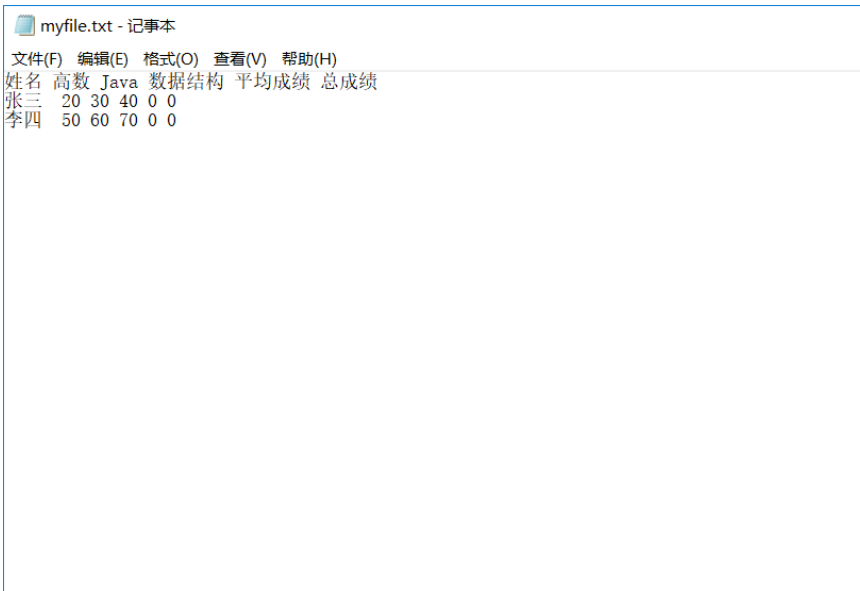
实验2 导入第4章示例程序并测试。
测试程序1:
l 编辑、编译、调试运行程序4-2(教材104页);
l 结合程序运行结果,掌握类的定义与类对象的用法,并在程序代码中添加类与对象知识应用的注释;
l 尝试在项目中编辑两个类文件(Employee.java、 EmployeeTest.java ),编译并运行程序。
l 参考教材104页EmployeeTest.java,设计StudentTest.java,定义Student类,包含name(姓名)、sex(性别)、javascore(java成绩)三个字段,编写程序,从键盘输入学生人数,输入学生信息,并按以下表头输出学生信息表:
姓名 性别 java成绩
(1)源代码:
(2)Employee.java、 EmployeeTest.java 运行结果截图:
1 import java.time.*;
2
3 /**
4 * This program tests the Employee class.
5 * @version 1.12 2015-05-08
6 * @author Cay Horstmann
7 */
8 public class EmployeeTest
9 {
10 public static void main(String[] args)
11 {
12 // fill the staff array with three Employee objects
13 Employee[] staff = new Employee[3];
14
15 staff[0] = new Employee("Carl Cracker", 75000, 1987, 12, 15);
16 staff[1] = new Employee("Harry Hacker", 50000, 1989, 10, 1);
17 staff[2] = new Employee("Tony Tester", 40000, 1990, 3, 15);
18
19 // raise everyone's salary by 5%
20 for (Employee e : staff)
21 e.raiseSalary(5);
22
23 // print out information about all Employee objects
24 for (Employee e : staff)
25 System.out.println("name=" + e.getName() + ",salary=" + e.getSalary() + ",hireDay="
26 + e.getHireDay());
27 }
28 }
29
30 class Employee
31 {
32 private String name;
33 private double salary;
34 private LocalDate hireDay;
35
36 public Employee(String n, double s, int year, int month, int day)
37 {
38 name = n;
39 salary = s;
40 hireDay = LocalDate.of(year, month, day);
41 }
42
43 public String getName()
44 {
45 return name;
46 }
47
48 public double getSalary()
49 {
50 return salary;
51 }
52
53 public LocalDate getHireDay()
54 {
55 return hireDay;
56 }
57
58 public void raiseSalary(double byPercent)
59 {
60 double raise = salary * byPercent / 100;
61 salary += raise;
62 }
63 }

(3)EmployeeTest.java源代码及运行结果截图如下
1 import java.time.LocalDate;
2 import java.util.Scanner;
3 /**
4 * This program tests the Employee class.
5 * @version 1.12 2018-09-25
6 * @author yangxiaoxiao
7 */
8 public class StudentTest
9 {
10 String name;
11 String sex;
12 double score;
13 public static void main(String[] args)
14 //public static void ScannerTest(){
15 {
16
17
18 int i = 0;
19
20 System.out.print("numer:");
21 Scanner sc= new Scanner(System.in);
22 int number = sc.nextInt();
23 StudentTest Stu[] = new StudentTest[number];
24 for (i = 0; i < Stu.length; i++) {
25 Stu[i] = new StudentTest();
26 System.out.print( (i + 1)+" "+"姓名:" );
27 Stu[i].name = sc.next();
28 System.out.print( (i + 1)+" " +"性别:");
29 Stu[i].sex = sc.next();
30 System.out.print( (i + 1)+" " +"java成绩:");
31 Stu[i].score = sc.nextDouble();
32 }
33
34
35 System.out.println("\t姓名\t性别\t成绩");
36 for (StudentTest StudentTest : Stu) {
37 System.out.println("\t" + StudentTest.name+ "\t" + StudentTest.sex + "\t" + StudentTest.score);
38 }
39
40
41 }
42 }
43
44
45
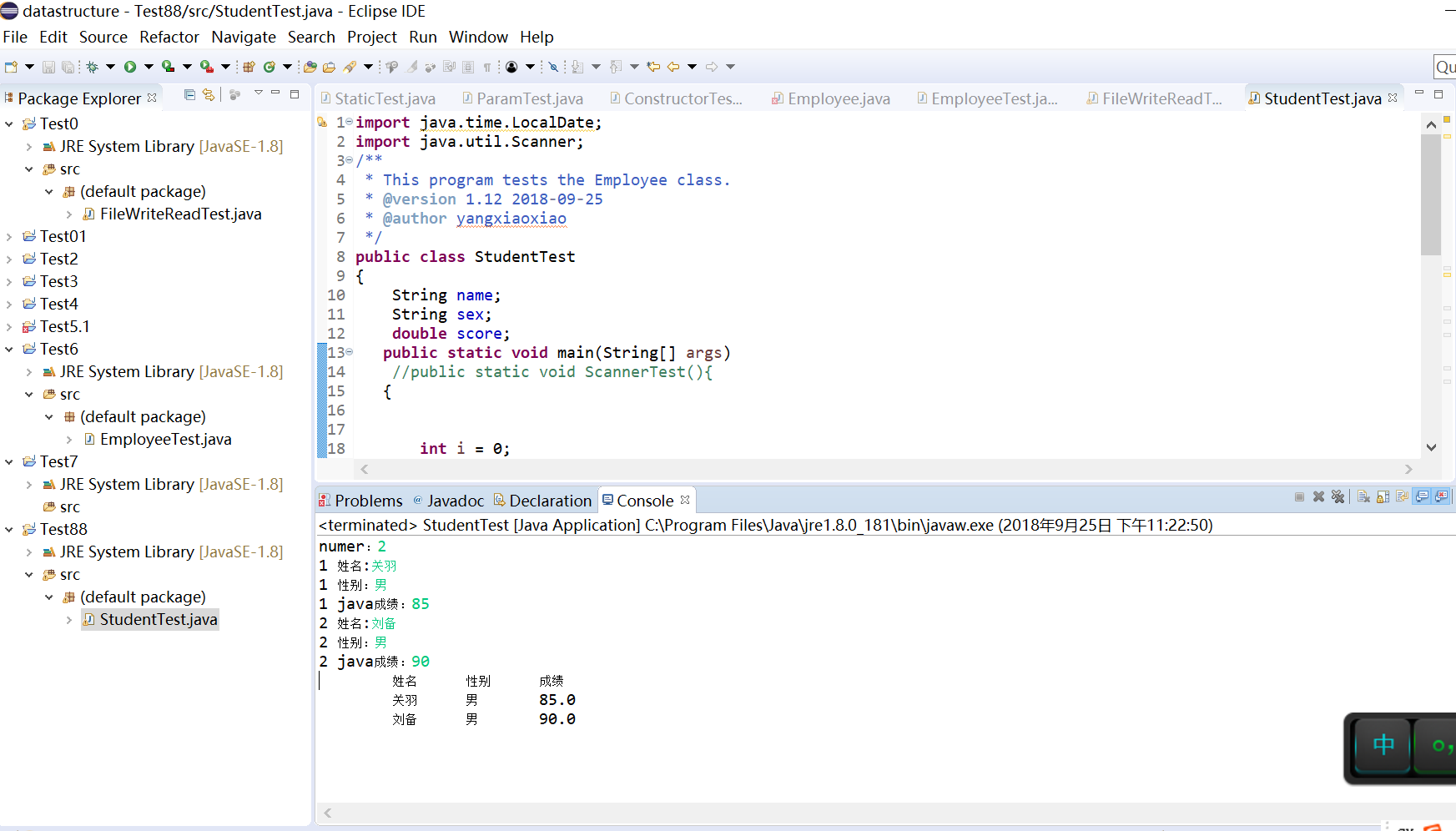
测试程序2:
l 编辑、编译、调试运行程序4-3(教材116);
l 结合程序运行结果,理解程序代码,掌握静态域(netxtId)与静态方法(getNextId)的用法,在相关代码后添加注释;
理解Java单元(类)测试的技巧。
1 /**
2 * This program demonstrates static methods.
3 * @version 1.01 2004-02-19
4 * @author Cay Horstmann
5 */
6 public class StaticTest
7 {
8 public static void main(String[] args)
9 {
10 // fill the staff array with three Employee objects
11 Employee[] staff = new Employee[3];
12
13 staff[0] = new Employee("Tom", 40000);
14 staff[1] = new Employee("Dick", 60000);
15 staff[2] = new Employee("Harry", 65000);
16
17 // print out information about all Employee objects
18 for (Employee e : staff)
19 {
20 e.setId();
21 System.out.println("name=" + e.getName() + ",id=" + e.getId() + ",salary="
22 + e.getSalary());
23 }
24
25 int n = Employee.getNextId(); // calls static method
26 System.out.println("Next available id=" + n);
27 }
28 }
29
30 class Employee
31 {
32 private static int nextId = 1;
33
34 private String name;
35 private double salary;
36 private int id;
37
38 public Employee(String n, double s)
39 {
40 name = n;
41 salary = s;
42 id = 0;
43 }
44
45 public String getName()
46 {
47 return name;
48 }
49
50 public double getSalary()
51 {
52 return salary;
53 }
54
55 public int getId()
56 {
57 return id;
58 }
59
60 public void setId()
61 {
62 id = nextId; // set id to next available id
63 nextId++;
64 }
65
66 public static int getNextId()
67 {
68 return nextId; // returns static field
69 }
70
71 public static void main(String[] args) // unit test
72 {
73 Employee e = new Employee("Harry", 50000);
74 System.out.println(e.getName() + " " + e.getSalary());
75 }
76 }
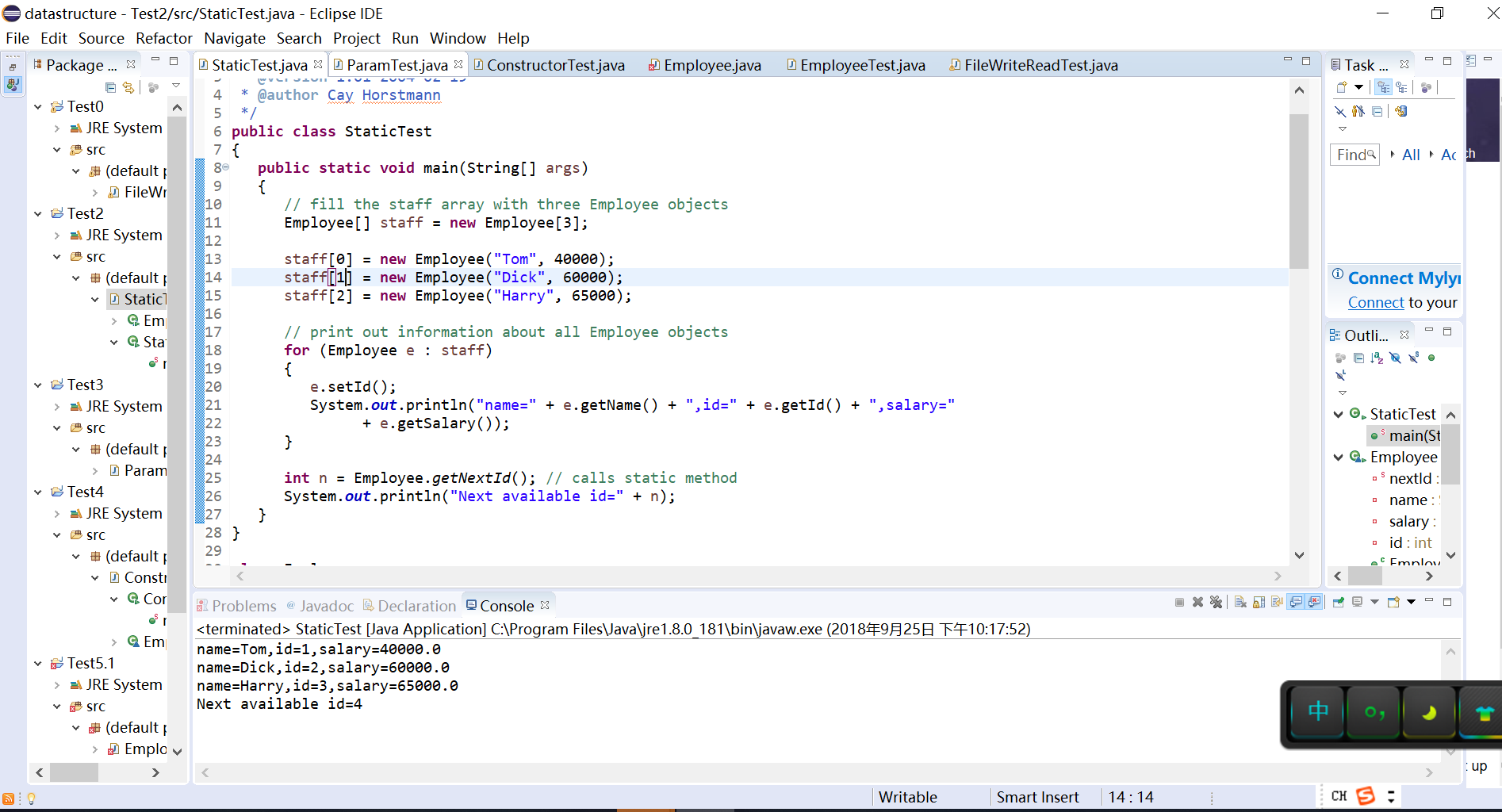
测试程序
l 编辑、编译、调试运行程序4-4(教材121);
l 结合程序运行结果,理解程序代码,掌握掌握Java方法参数的用法,在相关代码后添加注释;
1 /**
2 * This program demonstrates parameter passing in Java.
3 * @version 1.00 2000-01-27
4 * @author Cay Horstmann
5 */
6 public class ParamTest
7 {
8 public static void main(String[] args)
9 {
10 /*
11 * Test 1: Methods can't modify numeric parameters
12 */
13 System.out.println("Testing tripleValue:");
14 double percent = 10;
15 System.out.println("Before: percent=" + percent);
16 tripleValue(percent);
17 System.out.println("After: percent=" + percent);
18
19 /*
20 * Test 2: Methods can change the state of object parameters
21 */
22 System.out.println("\nTesting tripleSalary:");
23 Employee harry = new Employee("Harry", 50000);
24 System.out.println("Before: salary=" + harry.getSalary());
25 tripleSalary(harry);
26 System.out.println("After: salary=" + harry.getSalary());
27
28 /*
29 * Test 3: Methods can't attach new objects to object parameters
30 */
31 System.out.println("\nTesting swap:");
32 Employee a = new Employee("Alice", 70000);
33 Employee b = new Employee("Bob", 60000);
34 System.out.println("Before: a=" + a.getName());
35 System.out.println("Before: b=" + b.getName());
36 swap(a, b);
37 System.out.println("After: a=" + a.getName());
38 System.out.println("After: b=" + b.getName());
39 }
40
41 public static void tripleValue(double x) // doesn't work
42 {
43 x = 3 * x;
44 System.out.println("End of method: x=" + x);
45 }
46
47 public static void tripleSalary(Employee x) // works
48 {
49 x.raiseSalary(200);
50 System.out.println("End of method: salary=" + x.getSalary());
51 }
52
53 public static void swap(Employee x, Employee y)
54 {
55 Employee temp = x;
56 x = y;
57 y = temp;
58 System.out.println("End of method: x=" + x.getName());
59 System.out.println("End of method: y=" + y.getName());
60 }
61 }
62
63 class Employee // simplified Employee class
64 {
65 private String name;
66 private double salary;
67
68 public Employee(String n, double s)
69 {
70 name = n;
71 salary = s;
72 }
73
74 public String getName()
75 {
76 return name;
77 }
78
79 public double getSalary()
80 {
81 return salary;
82 }
83
84 public void raiseSalary(double byPercent)
85 {
86 double raise = salary * byPercent / 100;
87 salary += raise;
88 }
89 }
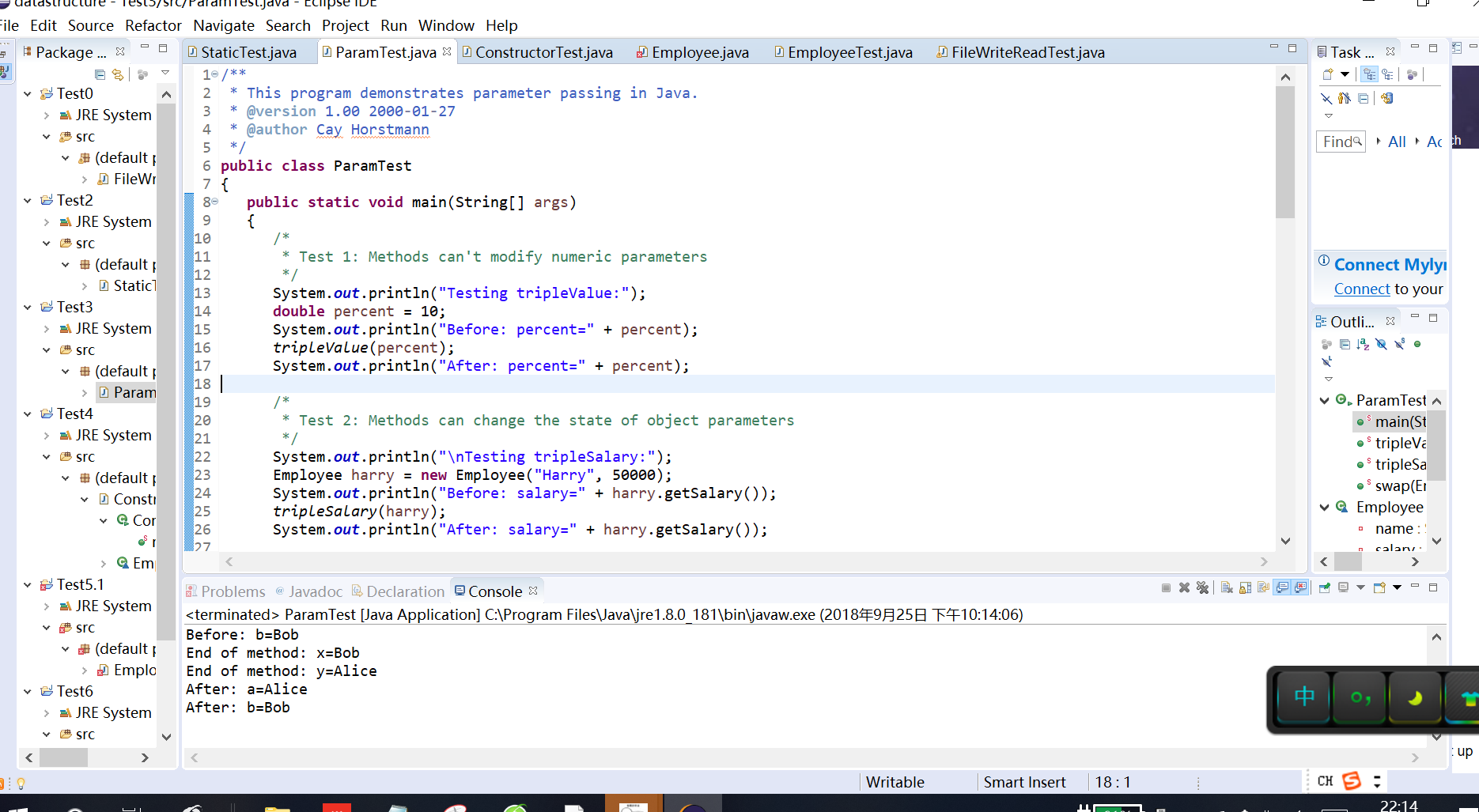
测试程序
l 编辑、编译、调试运行程序4-5(教材129);
l 结合程序运行结果,理解程序代码,掌握Java用户自定义类的用法,掌握对象构造方法及对象使用方法,在相关代码后添加注释。
1 import java.util.*;
2
3 /**
4 * This program demonstrates object construction.
5 * @version 1.01 2004-02-19
6 * @author Cay Horstmann
7 */
8 public class ConstructorTest
9 {
10 public static void main(String[] args)
11 {
12 // fill the staff array with three Employee objects
13 Employee[] staff = new Employee[3];
14
15 staff[0] = new Employee("Harry", 40000);
16 staff[1] = new Employee(60000);
17 staff[2] = new Employee();
18
19 // print out information about all Employee objects
20 for (Employee e : staff)
21 System.out.println("name=" + e.getName() + ",id=" + e.getId() + ",salary="
22 + e.getSalary());
23 }
24 }
25
26 class Employee
27 {
28 private static int nextId;
29
30 private int id;
31 private String name = ""; // instance field initialization
32 private double salary;
33
34 // static initialization block
35 static
36 {
37 Random generator = new Random();
38 // set nextId to a random number between 0 and 9999
39 nextId = generator.nextInt(10000);
40 }
41
42 // object initialization block
43 {
44 id = nextId;
45 nextId++;
46 }
47
48 // three overloaded constructors
49 public Employee(String n, double s)
50 {
51 name = n;
52 salary = s;
53 }
54
55 public Employee(double s)
56 {
57 // calls the Employee(String, double) constructor
58 this("Employee #" + nextId, s);
59 }
60
61 // the default constructor
62 public Employee()
63 {
64 // name initialized to ""--see above
65 // salary not explicitly set--initialized to 0
66 // id initialized in initialization block
67 }
68
69 public String getName()
70 {
71 return name;
72 }
73
74 public double getSalary()
75 {
76 return salary;
77 }
78
79 public int getId()
80 {
81 return id;
82 }
83 }
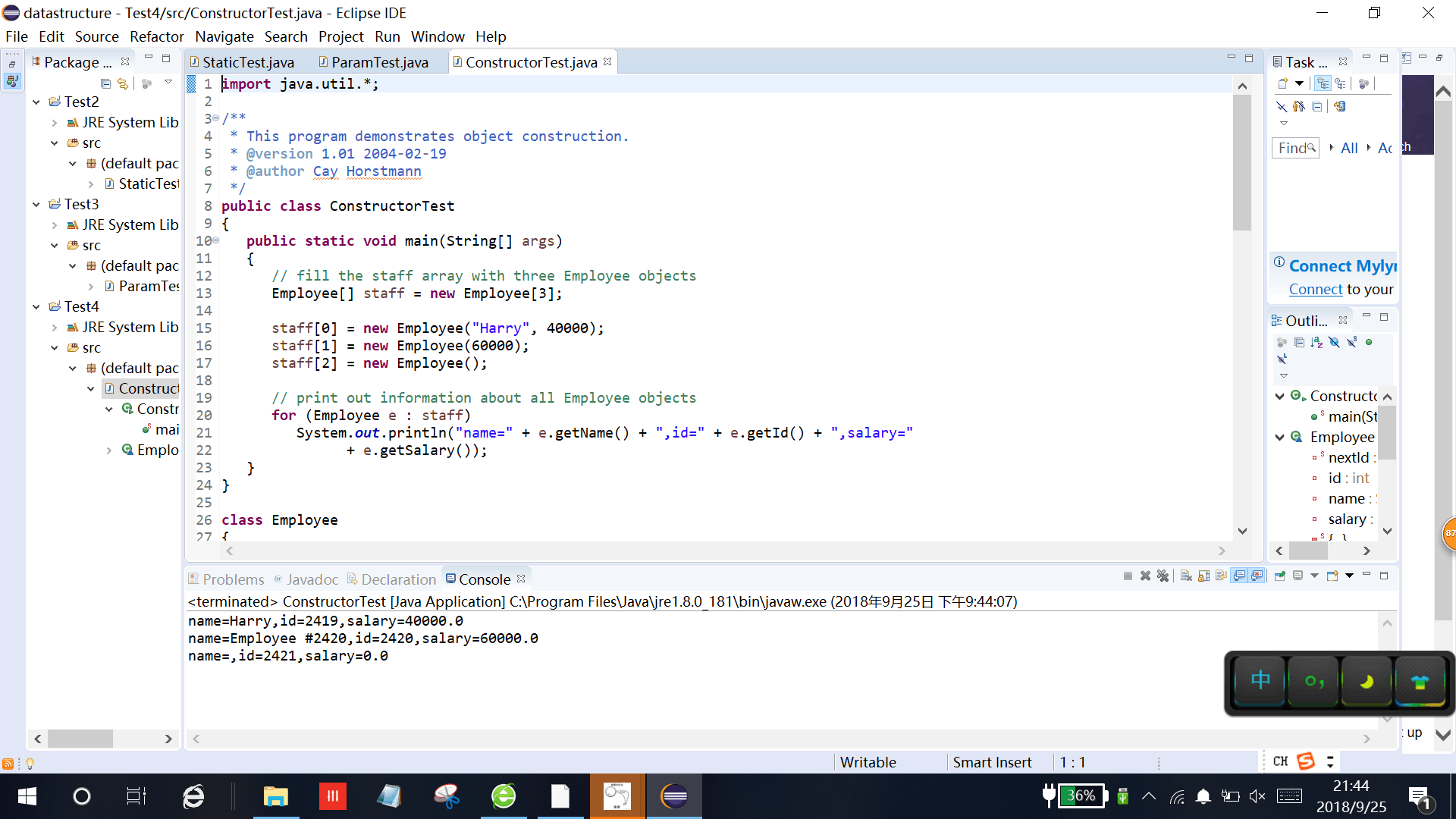
测试程序5:
l 编辑、编译、调试运行程序4-6、4-7(教材135);
结合程序运行结果,理解程序代码,掌握Java包的定义及用法,在相关代码后添加注释;
4-6
1 import com.horstmann.corejava.*;
2 // the Employee class is defined in that package
3
4 import static java.lang.System.*;
5
6 /**
7 * This program demonstrates the use of packages.
8 * @version 1.11 2004-02-19
9 * @author Cay Horstmann
10 */
11 public class PackageTest
12 {
13 public static void main(String[] args)
14 {
15 // because of the import statement, we don't have to use
16 // com.horstmann.corejava.Employee here
17 Employee harry = new Employee("Harry Hacker", 50000, 1989, 10, 1);
18
19 harry.raiseSalary(5);
20
21 // because of the static import statement, we don't have to use System.out here
22 out.println("name=" + harry.getName() + ",salary=" + harry.getSalary());
23 }
24 }
4-7
1 package com.horstmann.corejava;
2
3 // the classes in this file are part of this package
4
5 import java.time.*;
6
7 // import statements come after the package statement
8
9 /**
10 * @version 1.11 2015-05-08
11 * @author Cay Horstmann
12 */
13 public class Employee
14 {
15 private String name;
16 private double salary;
17 private LocalDate hireDay;
18
19 public Employee(String name, double salary, int year, int month, int day)
20 {
21 this.name = name;
22 this.salary = salary;
23 hireDay = LocalDate.of(year, month, day);
24 }
25
26 public String getName()
27 {
28 return name;
29 }
30
31 public double getSalary()
32 {
33 return salary;
34 }
35
36 public LocalDate getHireDay()
37 {
38 return hireDay;
39 }
40
41 public void raiseSalary(double byPercent)
42 {
43 double raise = salary * byPercent / 100;
44 salary += raise;
45 }
46 }
实验3 编写长方形类Rectangle与圆形类Circle,其中Rectangle类设置私有属性:width,length;Circle类设置私有属性radius。编写Rectangle类的带参构造函数Rectangle(int width,int length), Circle类的带参构造函数Circle(int radius),编写两个类的toString方法(Eclipse可自动生成)。上述2个类均定义以下方法:
求周长的方法public int getPerimeter()
求面积的方法public int getArea()
在main方法中完成以下任务:
(1) 输入1行长与宽,创建一个Rectangle对象;
(2) 输入1行半径,创建一个Circle对象;
(3) 将两个对象的周长加总输出,将两个对象的面积加总输出
(3) 将两个对象的周长加总输出,将两个对象的面积加总输出。
package 实验三;
import java.util.Scanner;
public class 实验3 {
public static void main(String[] args) {
Scanner sc = new Scanner(System.in);
System.out.println("请输入矩形的x y:");
int x = sc.nextInt();
int y = sc.nextInt();
System.out.println("矩形的c: "+Perimeter.getPerimeter(x,y));
System.out.println("矩形的area:"+Area.getArea(x,y));
System.out.println("请输入圆的半径r:");
int r = sc.nextInt();
System.out.println("圆c:"+Perimeter.getPerimeter(r));
System.out.println("圆area:"+Area.getArea(r));
double c = Perimeter.getPerimeter(x,y)+Perimeter.getPerimeter(r);
double s = Area.getArea(x,y)+Area.getArea(r);
System.out.println("矩形与圆的c之和:"+c);
System.out.println("矩形与圆的area之和:"+s);
}
}
class Perimeter{
public static double getPerimeter(double width, double height) {
return 2*(width + height);
}
public static double getPerimeter(int r) {
return 2*3.14*r;
}
}
class Area{
public static double getArea(double width, double height){
return width * height;
}
public static double getArea(int r) {
return 3.14*r*r;
}
}
实验结果如下图所示:
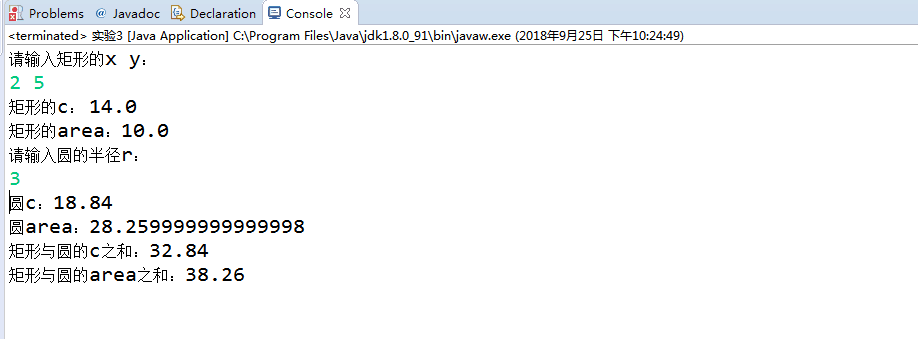
实验总结
通过本章《对象与类》的学习 ,首先对于本章的理论知识有了初步的了解。如使用预定义类,用户自定义类,静态域与静态方法,还有方法参数,包以及文档注释等等。另外,通过实验测试程序也对本章知识有了更多的认识。







 浙公网安备 33010602011771号
浙公网安备 33010602011771号